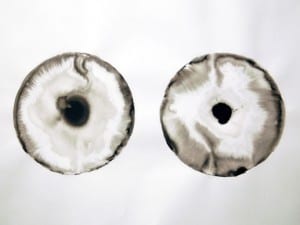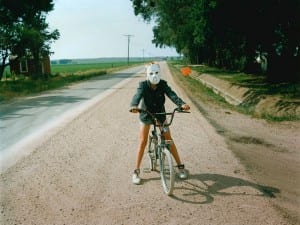Martin Boyce’s Eyes (2012) is the fourth work in the David Roberts Art Foundation’s (DRAF) study series; a selection of case studies intended to provide a fuller understanding of works from the DRAF collection. The work in question is at the far end of a long room, and takes the form of a large-scale wall-panel. At a distance its surface appears to be a dull, mottled, grey concrete. A blue pyramidal object juts from its centre, and is surrounded by a cluster of dark, angular symbols. Moving closer to the work, the concrete texture is revealed as wooden boards, arranged flush in a diagonal pattern; like a parquet-floor that has been raised up onto the wall. The surface of the wood has been roughly stripped, leaving it dreary and undefined.
In crisp contrast, the blue pyramidal form is aquamarine-painted, perforated steel. The metal is bent to form three distinct planes. Two holes cut into its surface become eyes, the top surface a jutting brow, and the two planes beneath it converge vertically to form a nose. It is a crude, empty-eyed face; a contemporary use of the tribal-mask features first appropriated in primitivism. The symbols that surround the mask are stylised Latin characters made from rough steel, and they appear to be tumbling down the wood surface. They spell, ‘ABSENT EYES’.
The gaze of the mask meets another pair of eyes. At the opposite end of the room a second face, this one black, wooden and sinuous, affirms the tribal quality of its angular counterpart. In this case, the mask is mounted directly on the wall and does not form part of a larger composition.
One of its eyes is an empty socket, whilst the other is filled in with yellow wood. It has long hanging cheeks and an exaggerated chin. The chin’s end has been snapped and is sharp and splintered. Its mouth is a perfect circle – an exaggerated look of shock. The mask could be a gasping monster from the theatre of Ancient Greece. Except, it is not a mask. It is an altered readymade, a modified leg splint; an example of those designed by Charles and Ray Eames during the Second World War.
On the wall adjacent to the splint is another large panel (Like Waterfalls, 2011). Its letter-strewn, wooden surface is painted with a large-scale geometric composition of turquoise and white. Though the pattern has a faultless copybook quality, the application of the paint is far from studious; drips of turquoise stain the white. As before, the steel lettering on the surface cascades downwards, but these characters are pristine and reflective, not rough and rusted, and the words they spell, ‘CURTAIN WALLS’, don’t easily jump out.
There is one more piece in the show. Across from Like Waterfalls, a small ventilation grille is set low down in the wall (Sound and Silence Wrought into Iron and Air, 2011). The thin white bars of the grille, framed against a black background of perforated steel, form a balanced composition – a system of horizontal slots in counterpoint with uniform diagonals.
The pattern on the grille is derived from Boyce’s study of the steel trees built by Joël and Jan Martel in 1925 for the Robert Mallet-Stevens garden, (part of the 1925 Exposition Internationale des Arts Décoratifs et Industriels in Paris) as is the form of the aquamarine mask and the design for the lettering used in Eyes and Like Waterfalls.
Eyes has been distanced from the other three pieces in the show. With half of the space to itself, it is unavoidably a focal point. The additional works are a support structure chosen to harmonise with its ideas and aesthetics, and provide an opportunity to reflect on its place within Boyce’s practice. The exhibition is not a study in any traditional or dry sense, but a link system, creating a dialogue with the chosen work.
In the exhibition literature several definitions and intents of the study series are given, perhaps most importantly: “the study is not finite, but demands the reader to take up multiple positions and viewpoints. More than anything, it asks the viewer to engage with the artwork by, at the very least, spending some time with it.”
Travis Riley
A study booklet can be accessed online: www.davidrobertsartfoundation.com
Study: Eyes – Martin Boyce, 15 March until 11 May, David Roberts Art Foundation, Symes Mews, London, NW1 7JE. www.davidrobertsartfoundation.com
Credits:
1. Martin Boyce. Like Waterfalls, 2011; Eyes, 2012. David Roberts Collection, London. Image Courtesy Annalisa Sonzogni
2. Martin Boyce. Eyes, detail, 2012. David Roberts Collection, London. Photographic Services, Basel.




